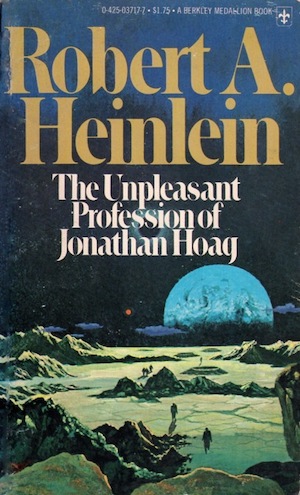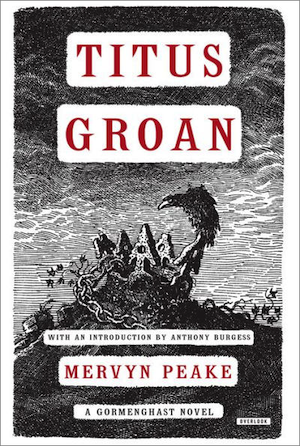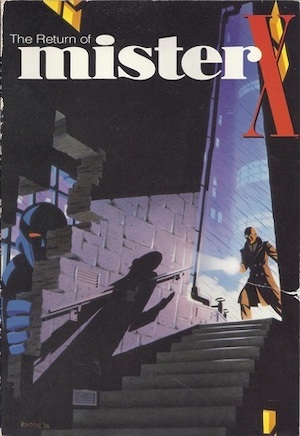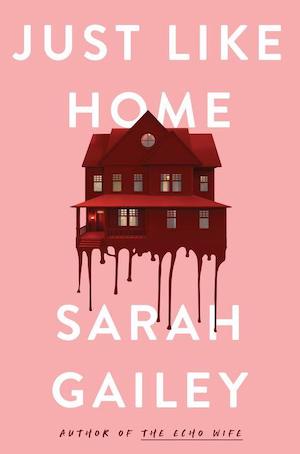There’s so much negativity in the world in which we live, and the internet only seems to exacerbate our unfortunate tendency to spotlight faults and shortcomings rather than looking on the brighter side of life. In the name of the optimism and positivity for which I am famous, I’d like to redress the balance. Consider the infamous H. H. Holmes.
These days, discussion of Holmes tends to focus on his more regrettable and extremely murderous proclivities, but in his way, Holmes was also an architectural visionary (depending on which accounts you believe—at the very least, Holmes’ “Castle” contained some hidden rooms, though it’s thought that they were mostly used to hide bits of furniture he hadn’t bothered to pay for). So, in the spirit of recognizing Holmes’ dubious achievements in building design and construction, here are five SFF works featuring bizarre and daring architecture!
The Bailey House (from “—And He Built a Crooked House—” by Robert A. Heinlein)

Frustrated by the limitations of Euclidian geometry, architect Quintus Teal yearns to construct for the Baileys a home unbounded by mundane dimensions. Physical practicalities appearing to preclude constructing the non-Euclidian structure he envisions, Teal settles for a three-dimensional representation of a hyperdimensional home. One fortuitous tremor later, and the construct folds, along dimensions humans cannot perceive, into the very form of which Teal dreamed.
Will the Baileys be delighted by their hyperdimensional home? Will they survive their first tour? These are questions that can only be settled by venturing into the hypercube house.
I wonder if a tendency to shuffle into a trans-dimensional mode is covered by building codes? Such a shuffle doesn’t seem like it would be directly life-threatening, although I can see how needing to navigate directions humans cannot perceive could be troublesome. Particularly if one were looking for the toilet.
Castle Gormenghast (From Titus Groan, by Mervyn Peake)

The earldom dominated by rambling Castle Gormenghast is surrounded on all sides by forbidding geography. Castle Gormenghast itself is a vast Gothic structure whose labyrinthine extent is poorly documented (and judging by certain events, even more poorly maintained). It’s the perfect setting for young Titus and his collection of dubiously sane relatives to pursue their eccentricities to their logical conclusions.
There are many aristocrats (most of whom are now dead) who tempt one to consider the benefits of guillotines. In the case of Titus’s extended family, while they do seem like bad bosses, the Castle appears to contain them quite effectively. The Castle is a kind of a roach motel for inbred blue bloods.
Radiant City (From The Return of Mister X by Dean Motter, Gilbert Hernández, and Jaime Hernández)

Radiant City as originally envisioned would have provided its inhabitants with utopia; its very geometries were planned to encourage the best in human nature. Practical considerations demanded extensive compromise. Result: a world-class city whose bizarre geometries erode human minds.
The good news is that Radiant City’s architect, now known as Mr. X, is determined to use his knowledge to counter the ill effects of Radiant City psychetecture. Too bad that the government, fearfully corrupt, opposes him. Even worse: Mr. X uses drugs to remain awake and productive—drugs that are eroding his sanity and compromising his judgment. Ill effects march on.
The City (From Girl’s Last Tour by Tsukumizu)

Long before sisters Yuuri and Chito were born, humanity demonstrated its unchallenged dominance over puny nature by constructing a vast complex of metropoles and megastructures covering (as far as can be gleaned from the manga) the entire surface of the Earth. Human supremacy was made manifest.
As Yuuri and Chito spend six volumes discovering, one consequence is that setbacks became non-recoverable: if civilization falters, if people forget how to repair the machines on which they depend, only lingering death and final extinction are possible. Nevertheless, the reduction of the Earth’s ecosystems to a small handful of dying remnants stands as an impressive triumph of the human will and vision.
Crowder House (From Just Like Home by Sarah Gailey)

Vera Crowder returns to her natal home to care for the sickly mother who cast Vera out twelve years ago. Following public revelation of Vera’s father Francis’ curious hobbies, Vera has tried to hide her connection to infamous serial killer Francis Crowder. Her mother, in contrast, embraced notoriety for its income potential. Neither truly appreciates the legacy Francis provided in the form of Crowder House itself.
Vera’s situation—the daughter of a famous serial killer moving in with a mother who blames Vera for her role in Francis’ downfall, returning to a town populated by the relatives of her father’s victims—may seem fraught. Let me assure readers it’s so much worse than it appears. The result is the exact opposite of a feel-good novel.
***
Strange and unusual architecture has inspired many authors; the works I’ve mentioned are only a small sample of what is doubtless a very large number of such works. Readers who have their own favourites not yet mentioned may feel free to mention said works in comments, which are, as ever, below.
In the words of fanfiction author Musty181, four-time Hugo finalist, prolific book reviewer, and perennial Darwin Award nominee James Davis Nicoll “looks like a default mii with glasses.” His work has appeared in Interzone, Publishers Weekly and Romantic Times as well as on his own websites, James Nicoll Reviews (where he is assisted by editor Karen Lofstrom and web person Adrienne L. Travis) and the 2021 and 2022 Aurora Award finalist Young People Read Old SFF (where he is assisted by web person Adrienne L. Travis). His Patreon can be found here.










